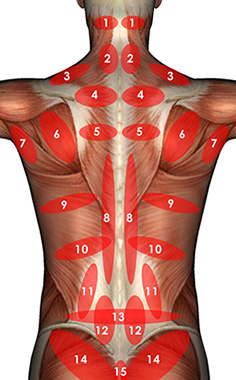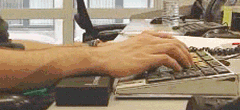Paul Manley Back Pain and RSI Clinic
Paul Manley, M.A.O.(Manip), Registered OsteomyologistFor muscle and joint problems

RSM (Royal Society of Medicine)
Specialist in the treatment of Musculo-skeletal problems
Location: 8-10 Boston Place, Marylebone, London NW1 6QH
Next to Marylebone Station, Main line trains and Bakerloo line
19/01/2026
Diagnosis and treatment of RSI
What is RSI?>> RSI muscle triggers>> RSI nerve triggers>> RSI pathophysiology>> RSI treatment
The experienced hand sees by touch, the shapes, densities, heat, textures, resistances of the body, the trained mind puts it all together. The trained hand stretches and softens the specific muscles, tendons and joints as mentioned above, the experienced mind asks questions pertinent to usage and the particular trigger area under investigation. These can reveal additional information about any other activities that the RSI suffer is engaging in which might be adding an additional trigger area.
I am able, by virtue of specialised and unique hands-on techniques that I call ‘Myo-articulation’, to reverse deep tension patterns quite swiftly. If there is carpal bone derangement present, I can very specifically locate and ‘undo’ adhesions and re-align these delicate little bones of the wrist. I will ‘track’ the tension patterns along the arm and identify shoulder, ribcage and neck involvement. These I will then release using a variety of techniques such as articulation, massage and manipulation where necessary.
It is even possible to identify, by palpating the tensions in individual muscles, specific playing related patterns of overuse such as the little finger in trills on the violin, over- gripping and over-flexing in the bowing hand and mouse and typing habits.

Whilst 'weakness' in the muscles' is much ballyhooed, it is more usually the best procedure to save strengthening exercises until the last, once the deep muscles and joint problems have been corrected. The action of correcting a muscle will induce muscle growth anyway. It is often wise to tone up the secondary muscles involved in a given action. Typing, for example, has the Deltoid muscles as secondary stabilisers holding the arms slightly out from the body. If you strengthen these muscles the arm will feel lighter. If the Deltoids are too underused then the deep primary stabiliser, Supraspinatus will become hypertonic and will constitute another trigger area.
When I began many years ago, I took it all for granted. Having been brought up as a boy in an Osteopathic environment I didn't realise that there were many things that people didn't know about in connection with the workings of the body and what makes them function that I took for granted. Hence, trying to take the thorny subject of RSI and shake some common sense into it for you.
Sure, there are other factors potentially involved. Psychological elements, metabolic factors, ergonomic, posture, hydration levels, diabetes, hypoxia, hypercalcemia, even pollution levels, but here I have restricted my talk with you to those things that seem to be least understood by sufferers. I hope it helps you to understand more deeply the whole painful subject of RSI.

What is RSI?>> RSI muscle triggers>> RSI nerve triggers>> RSI pathophysiology>> RSI treatment
07925 616 753
Location: 8-10 Boston Place, Marylebone, London NW1 6QH
Next to Marylebone Station, Main line trains and Bakerloo line